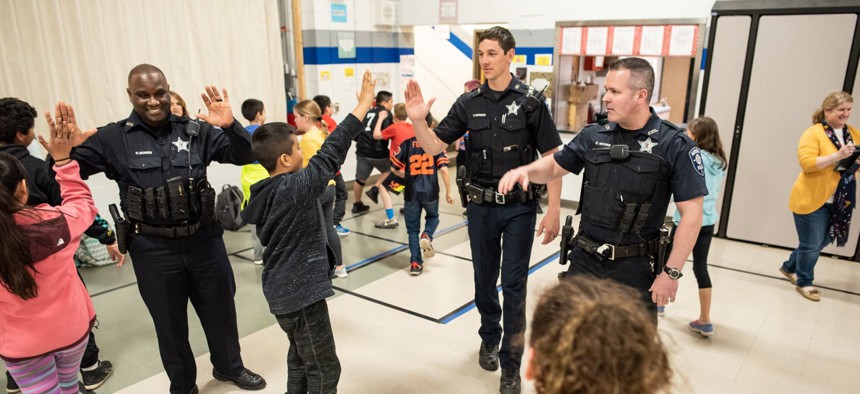How One City Dramatically Cut Its Murder Rate

A cornerstone of the Aurora policing initiative is creating more positive interactions between police and residents, especially youth. Aurora Police Department
With a focus on community policing and engagement with neighborhood groups, Aurora, Illinois has become a model for cities across the country.
There were 26 murders in Aurora, Illinois in 2002. Ten years later, when the city had zero murders for the first time in six decades, it made national news, focused on how the second-largest city in Illinois had seen such a sharp decline in killings.
Clayton Muhammad, the Chicago suburb’s chief communications officer, credits the transformation to the sustained engagement of neighborhood organizing groups with the police, the success of youth programs meant to deter kids from joining gangs, and the implementation of community policing. Now, with a consistently low murder rate (there were just four murders in 2018), city officials are regrouping to see how they can continue to improve safety for Aurora residents.
“Based on the experience we had in those ten years,” Muhammad said, “we knew we had to make a concentrated effort to engage across the board.”
The city has a population just over 200,000 and has been recovering since the 1980s from a boom in violent gang-related crime and a high unemployment rate due to the closure of local factories. In the early 2000s, officials wanted to focus in particular on improving the relationship between the police force and the community. To accomplish this, they first turned to community organizations as a way to identify the concerns coming from different places within Aurora’s 45 square miles.
The Office of Neighborhood Group Support was charged with reviving community organizations in areas where public safety improvements had led to the groups disbanding or where no young members had joined in a while. The city office also helped create new groups in places where they hadn’t previously existed. The city then encouraged these organizations to bring the issues they saw on their blocks to city-wide neighborhood meetings.
What they heard in those meetings led officials to then create more opportunities for the police and community members to interact in non-emergency situations. They opened City Hall for trick-or-treating on Halloween and worked with neighborhood groups to plan more than 40 community events throughout the year, including one on National Night Out. “In essence, we’re taking small things and connecting them together to create a renaissance for public safety and engagement,” Muhammad said.
In coordination with making police more visible, they also made officers’ beats community-centric. Now, cops are assigned to areas as specific as neighborhoods, schools, and community groups, and are tasked with serving as a liaison for the police force when community groups and school officers bring up concerns. Some have even started their own community programming, such as Officer Skyy Calice, who began the leadership program Girls Run the World in three area high schools. “That isn’t the norm, but it’s indicative of the commitment our police have,” Muhammad said. “It’s a domino effect as officers become more familiar with the lay of the land and expand deeper into their communities.”
Muhammad said the community-centered approach is important to maintain a proactive, rather than reactive, response to community-police tensions, especially given the prevelance across the country of videos of police brutality. “We’re one trigger move away from being the next community on CNN, and that can be disheartening,” he said. “So we keep a pulse on the national climate, and while we know people can be afraid of the police, we try to help them trust us.”
The constant barrage of videos of people, usually young and black, being shot by police can be traumatic for young people, especially those of color, said Thomas LaVeist, the dean of the School of Public Health and Tropical Medicine at Tulane University. “News stories about injustice can cause broad trauma,” he said. “Humans are very social by nature, and seeing these stories leads to a sympathetic response, a stress response. If we perceive threats, it leads to a fight or flight state where we become more vigilant.”
LaVeist said that vigilance can lead to physical health consequences like high blood pressure, but it can also lead to distrust of the police, which can be deadly. He pointed to the case of Freddie Gray, who died after he was arrested by Baltimore police in 2015. He was originally apprehended when he made eye contact with the police and started running, even though he was not engaging in any illegal activity. “He was probably anticipating victimization,” LaVeist said. “His response was one of someone showing hypervigilance.”
That’s exactly the scenario that Aurora city officials hope to avoid in their community. “Bias within the police ranks brings out mass protests,” Muhammad said. “So we work on implicit bias training, and we have honest and proactive conversations about it. We always say, ‘you don’t rise to the level of your training, you fall to the level of it,’ so we train seriously.”
The city also focuses on working with young people who are frequently exposed to viral videos of police bias or brutality. “We’re sitting down with youth, the people who know these things are happening from social media, so we can start to break down the barriers of distrust,” Muhammad said.
When police engage in that sort of behavior, LaVeist said, they can start to break cycles of crime. “To unravel that vigilance, people need to have real experiences with government that are trustworthy, such as positive interactions with police imbedded in the community, as opposed to stop-and-frisk-type policies,” he said.
To make government trustworthy, Aurora leaders believe it has to be shaped by and rise out of the community. “A lot of our leadership—our mayor, our police chief, our fire chief—they’re all hometown kids who have lived through the cycles of the city. It’s not a coincidence that the leadership improving the city was once in the shoes of the people we are trying to serve,” Muhammad said. “It makes an enormous difference.”
But for all their improvements, the city is not without challenges. In February of this year, Aurora made headlines when a mass shooting left six people dead. But with that tragedy came the chance to share the city’s story, and Aurora’s police chief, Kristen Ziman, took to the road to talk strategy with law enforcement in other places.
“We’re very open,” said Muhammad. “We get questions all the time from other cities. But our answer is usually ‘you have to see what works for your city.’ This isn’t a cookie cutter. What works for us might not work for somewhere else.”
That doesn’t mean people will stop asking for tips, though. Aurora’s work on community relations was recognized recently by Bloomberg’s Cities of Service through their annual Engaged Cities awards. “We’ve been working on this for so many years, it’s like our baby. And we think our child is great, but when the teacher says your kid is amazing, and they bring home good ACT scores and scholarships, that confirms we’re doing something right,” Muhammad said. “We have so much left to work on, but we’re celebrating this success—that objective observers are finally seeing the Aurora we’ve always wanted to be.”
Emma Coleman is the assistant editor for Route Fifty.
NEXT STORY: Can Protecting Land Promote Employment?






